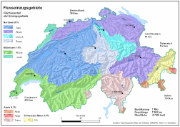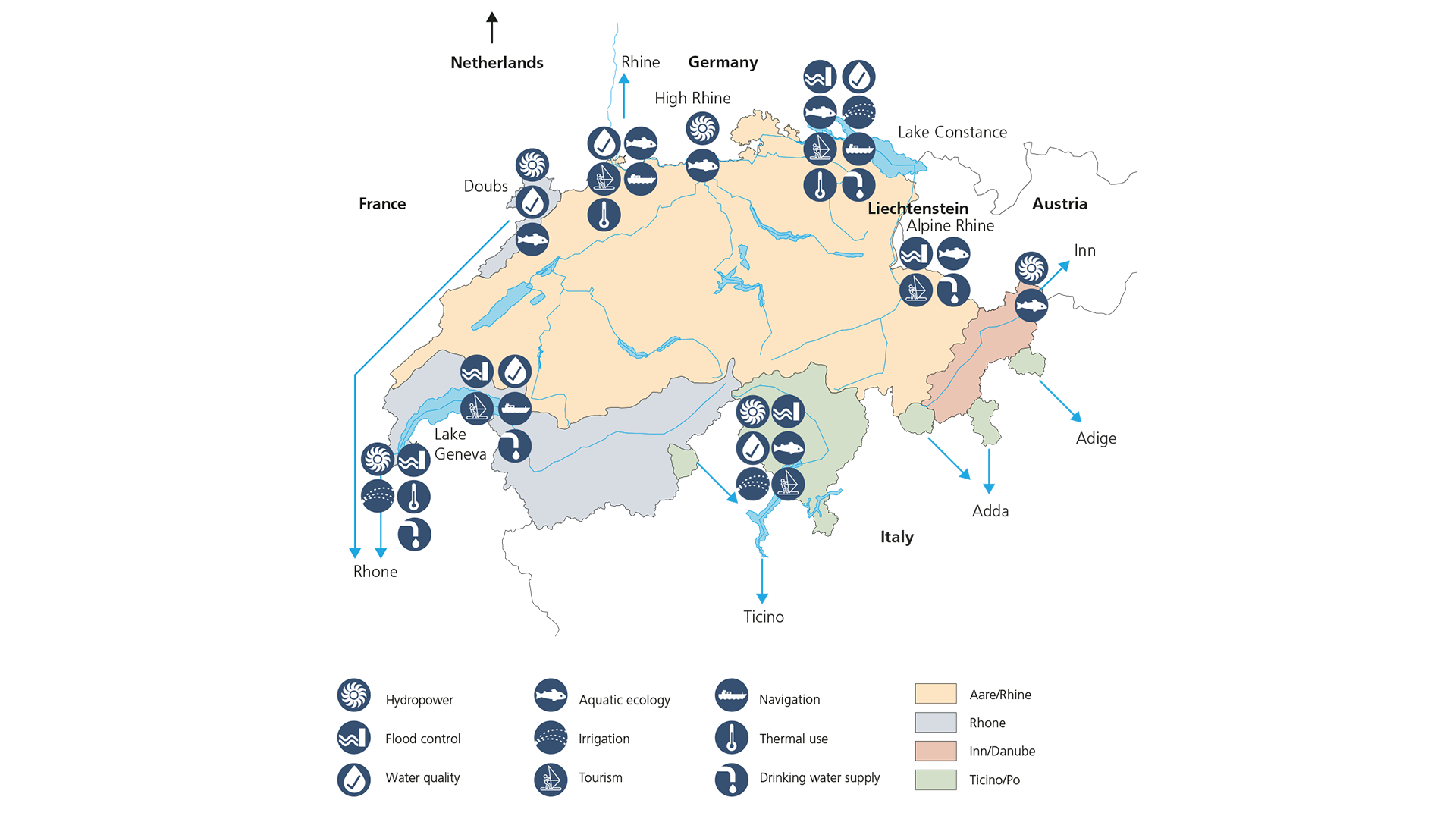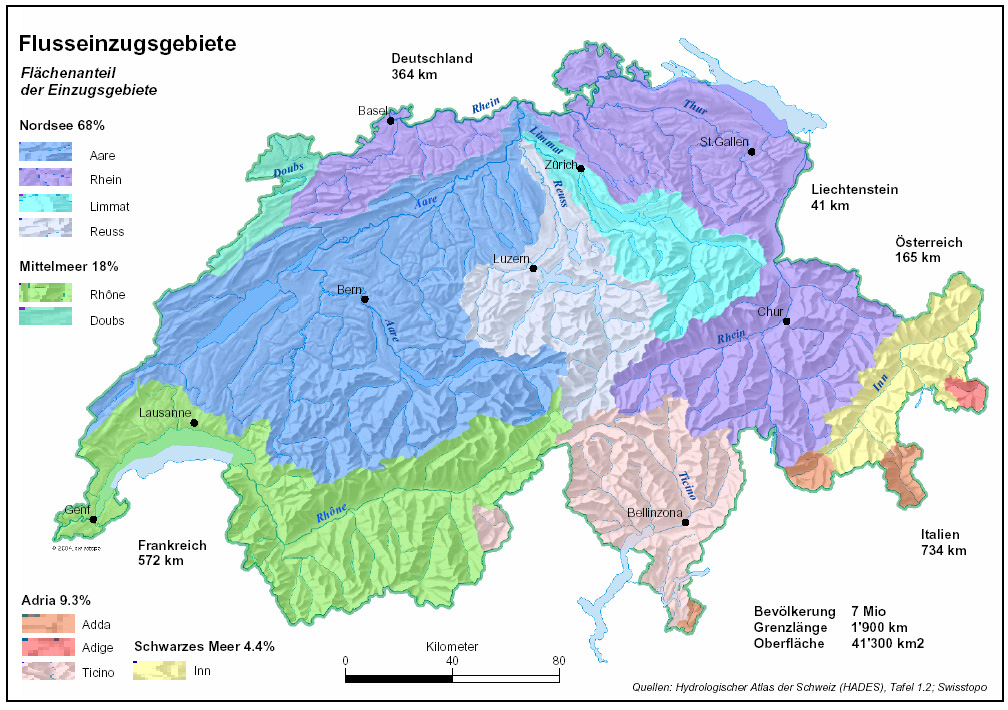Neighbouring countries of Switzerland use the water that flows across its borders. For decades, international agreements, treaties and bodies have been governing cooperation in this area and setting objectives for transboundary waters.
Switzerland a rich source of water within Europe

Switzerland is well known as a rich source of water: It has 6% of Europe's freshwater resources, although it only accounts for 0.4% of the total area of the continent. Some of Europe's largest rivers, the Rhine and the Rhône, rise in the Saint Gotthard massif. Switzerland's water supply in the form of mean annual precipitation (1456 mm) is almost twice the European average (770 mm).
The largest proportion of the country (67%) is drained via the Rhine into the North Sea. As a result, the catchment areas of the waters flowing into the Mediterranean (Rhône, 18%), the Adriatic (Po, 9.3%) and the Black Sea (Danube, 4.4%) are correspondingly smaller.
Conventions and forums
Water Convention
Water knows no boundaries. Not counting lakes, there are 286 transboundary watercourses, as well as 592 transboundary aquifers.
The 1992 Convention on the Protection and Use of Transboundary Watercourses and International Lakes, which was developed for the United Nations Economic Commission for Europe (UNECE) region, went global in 2016 based on a proposal by Switzerland. Its objective is to promote international cooperation in order to protect water quality and guarantee the sustainable use of transboundary surface and underground waters. The Convention sets out the requirement of adopting integrated water resources management. A secretariat in Geneva supports these efforts, which involve numerous working groups focused on various aspects, such as water and climate change, the benefits of transboundary cooperation, relationships with agriculture and energy, the financing of cross-border cooperation etc.
OSPAR Commission
Nitrogen inputs from wastewater treatment plants are one of the main contributors to the alarming levels of marine pollution. Switzerland is committed to reducing inputs of nitrogen into the Rhine and North Sea.
Ramsar Convention on Wetlands
The Convention on Wetlands is an intergovernmental treaty that provides the framework for national action and international cooperation for the conservation and wise use of wetlands and their resources. This instrument also addresses the management of biological diversity and water.
World Water Forum
The World Water Council (WWC), a non-governmental organisation, started the World Water Forum (WWF) in response to the problems of the constantly increasing global population and in view of better management of freshwater resources. Every 3 years, a World Water Forum, which is an informal meeting, is held by a country and attended by governments, international organisations, the private sector and non-governmental organisations.
World Water Week in Stockholm
World Water Week takes place every year in Stockholm, Sweden and attracts governments, academics and NGOs. During the week, specific innovative themes are explored in depth and the prestigious Stockholm Water Prize, the “Nobel” prize for water, and the Industry Water Award are presented.
International water protection commissions
As well as being home to more than 6% of Europe's freshwater reserves, the sources of some of the continent's major rivers, such as the Rhine and the Rhone are located in Switzerland. Switzerland fulfils its water protection responsibilities vis-à-vis its European neighbours and is an active member of various international water protection commissions.
International Commission for the Protection of the Rhine (ICPR)
The Convention on the Protection of the Rhine instituted the International Commission for the Protection of the Rhine, whose members are France, Germany, Luxemburg, the Netherlands, Switzerland and the European Commission. The members work with Austria, Liechtenstein, the Belgian region of Wallonia and Italy to conserve and restore the Rhine ecosystem. Their activities focus on the sustainable development of the Rhine and its floodbanks and the restoration of all water in the basin. One of the objectives of the Rhine 2040 Programme, which was adopted in 2020, is to complete fish passability. In other words, migratory fish shall again be able to migrate from the North Sea up to the Rhine Falls at Schaffhausen and colonise their habitats.
International Water Protection Commission for Lake Constance (IGKB)
The IGKB – International Water Protection Commission for Lake Constance – is an important body that cares for the overall condition of Lake Constance. It was founded in 1959 by the countries bordering the lake and the Principality of Liechtenstein. It recommends to its member countries measures to keep the Lake Constance ecosystem in a good, intact condition.
Commissione Internazionale per la Protezione delle Acque Italo-Svizzere (CIPAIS)
The agreement between Switzerland and Italy on protecting Swiss–Italian rivers and lakes against pollution was concluded on 20 April 1972. Under this agreement, the Swiss Federal Council and the Italian government decided to work together closely to protect Italian–Swiss surface and groundwater resources from pollution, in particular those that affect pollution levels in:
- Lake Lugano (Ceresio)
- Lake Maggiore (Verbano)
- rivers that mark or cross the border, e.g. the Doveria (VS-I), Melezza (TI-I), Giona (TI-I), Tresa (TI-I), Breggia (TI-I), Mera (GR-I), Poschiavino (GR-I) and Spöl (GR-I).
To this end, the two governments set up a joint commission for the protection of Italian-Swiss Waters against pollution.
International Commission for the Protection of the Waters of Lake Geneva (CIPEL)
The International Commission for the Protection of the Waters of Lake Geneva (CIPEL) was set up in 1963 as an intergovernmental Franco–Swiss organisation to coordinate the management and protection of the waters of the Lake Geneva basin. This cross-border cooperation covers the areas of the French departments of Ain and Haute-Savoie as well as the Swiss cantons of Vaud, Valais and Geneva. CIPEL strives to harmonise environmental policy between France and Switzerland in order to preserve the quality of Lake Geneva's water, which is a vital resource for the local population and ecosystems.
International Commission for the Hydrology of the Rhine basin (CHR)
The CHR is an organisation in which scientific institutes of the Rhine riparian states jointly formulate hydrological measures for sustainable development of the Rhine basin. The CHR was founded in 1970 following advice by UNESCO to promote closer cooperation in international river basins. Since 1975, the work has been continued under the UNESCO International Hydrological Programme (IHP) and the World Meterological Organization’s Operational Hydrological Programme (OHP). The member states of the CHR are: Switzerland, Austria, Germany, France, Luxembourg and the Netherlands.
Monitoring and hydrological forecasts
International monitoring station at Weil am Rhein
To permit continuous monitoring of water quality in the Rhine, Switzerland, together with the German state of Baden-Württemberg, has also established an international monitoring station at Weil am Rhein. The station, maintained by the Basel-Stadt Environment and Energy Office, is part of the ICPR's warning and alarm system for the Rhine.
International cooperation with forecasting services
The measurement data and forecasts from the
Swiss catchment areas are important for predicting what will happen downstream. There is therefore long-standing cooperation with hydrological forecasting services along the Rhine. The Lake Constance riparian states also operate a joint water level forecasting system.
Adaptation to climate change
The effects of climate change in Switzerland are also being felt by regions downriver. For example, low water levels in the Rhine are expected more frequently downriver of Basel, leading to problems with water supply, irrigation and losses in hydropower production in Germany, France and the Netherlands. International cargo transport on the Rhine is also affected.
A cross-border conflict of interests can be seen at Lake Maggiore (water reserves for irrigation and flood protection).
Adaptation to climate change therefore also requires the riparian states to agree on how to manage rivers and lakes beyond national borders. This involves both further improving water quality and coordinating cross-border water management. Many conflicts can be avoided by using water efficiently and focusing on the most important uses for society.
Last modification 19.05.2025








